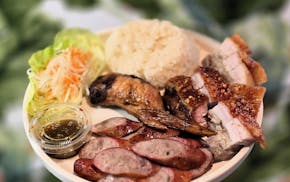During several visits to Ireland, prolific Minneapolis cookbook author Zoë François became obsessed with the simple scones that she seemingly encountered everywhere.
"My first stop after the long flight was to a farm, where I had my first Irish scone with marmalade," she writes on her blog, zoebakes.com, an inspiring resource that should be bookmarked by bakers of all stripes. "The love affair with the country and its scones was set in that moment."
Bake these tender, golden scones in honor of St. Patrick's Day. After that, the recipe will quickly earn a berth in your baking rotation, because these uncomplicated crowd-pleasers come together in a snap, and they're delicious.
The same can be said for François' rendition of kumquat marmalade: easy to prepare, and an essential component to the scone-devouring process.
"Every table in Ireland served scones with a jar of marmalade, which pretty much satisfies all my needs," she wrote. "I love marmalade! It is the perfect balance of sweet and bitter."
Sold. In a recent all-about-scones conversation, here's François on ...
What makes a scone "Irish": "In Ireland, a scone is a scone is a scone. Wherever you go, they're very similar. There may be some small tweaks from family to family. In America, you find every shape, size and flavor. But in Ireland, they're all the same size, and they're round, and there won't be anything in them. You'll have one for breakfast, and there will be a thousand things to put on it."
The power of Irish butter: "Why I dreamed about these scones after leaving Ireland was the butter. I've never had dairy like that, and not just the butter. I had this Victoria sponge with strawberry jam and whipped cream, and I was certain that there was something else in that whipped cream — sour cream, or mascarpone — because it was so rich. Their cream is fattier, and their butter is fattier. They leave all the fat in, and that makes all the difference. Obviously, because it's Ireland, it's all grass, and the cows eat grass all the time, and so the cream tastes different. The color is so pretty, and the texture and the flavor is so good. I didn't get that until I went there."
Tips for first-time scone bakers: "This recipe is so easy. If you're entering the scone/biscuit world, this is a good one to start with. It's not one of those where you have to keep the butter super-cold, it's not one of those crazy recipes where it's going to fall down on you. A lot of recipes from Ireland and England and Australia use self-rising flour, but I find that it can be tricky for people. I translated the recipe back to all-purpose flour. That's what Americans use. Self-rising flour has just never caught on here."
Making marmalade with kumquats: "I used them because they were in season — although these days you can get anything, anytime — and they're beautiful. And I had them in front of me, which is the answer to everything that I do. I just love the flavor, I'll pop them in my mouth while I'm cooking. They have a beautiful texture, too, and that lends themselves to a quick and easy marmalade. I have done this with grapefruit, and even Key limes, and you could do lemons, too, although you need a lot more sugar because they're more tart. Dried cherries would be interesting, too. I'll take prunes and oranges and do almost exactly the same thing, cooking them down with a cinnamon stick and star anise. Marmalade is just so good."
Traditional Irish soda bread: "It's not something that's on my radar, but when I do have it, I think, 'Why don't I make this?' It's so easy. I love it, I'm a big fan, I just don't think of making it."
Her new Magnolia Network television series, "Zöe Bakes": "I have the one pilot episode out there, and I have 10 other episodes that are not out in the world yet, I'm not sure when they will be. I feel like I just figured out the publishing world after my ninth book ["Zoe Bakes Cakes," to be released March 16], and TV is similar in some ways, and different in others. I got to make the show that I wanted, and that makes me very happy. I got to showcase the people that I wanted to showcase, and I got to make it about baking and technique. I talked to other networks, and they wanted me to do dump-and-stir — that's using mixes, and putting my stamp on it — and that's not the kind of baking I know. I was super lucky that Magnolia was as interested in the craft of baking as in making a pretty show." (Watch the first episode now on Discovery Plus.)
Adding currants, chocolate and other flavorful ingredients to scones: "This is going to get me into so much trouble, and now I'm never going to get invited back to Ireland. I'm American, so of course I throw other things in there, although then I would never call it an 'Irish' scone. In my post, I keep it traditional. But in the show, we have an episode about pumpkins, and I made scones with butternut squash and white chocolate. They're awesome. So, yes, I just can't leave well enough alone. That's the fun of it."
Irish Scones
Makes about 1 dozen scones.
Note: From Zoë François of zoebakes.com. High-fat-content European-style butters, such as Kerrygold Pure Irish Butter, Président and Plugrá brands, are available in the dairy section of many supermarkets.
• 4 c. flour, plus more for shaping dough
• 1 tbsp. baking powder
• 1/2 tsp. baking soda
• 1/4 tsp. salt
• 3 tbsp. sugar, plus more for decoration
• 1/2 c. (1 stick) unsalted "European" butter (see Note), chilled, but not quite hard, so it can be easily worked into the flour
• 2 c. buttermilk
• 1 egg
Directions
Preheat oven to 400 degrees and line a baking sheet with parchment paper.
In a large bowl, whisk together the flour, baking powder, soda, salt and sugar. Cut the butter into small pieces and add to the flour mixture. With your fingers, rub the butter into the flour mixture until it resembles cornmeal. The flour mixture should be fully coated with the butter and it will turn creamy in color.
Gently stir in enough of the buttermilk to create a moist dough that still holds its shape; you may not use all of the buttermilk. There should be a few dry patches at the bottom of the bowl as you are mixing in the buttermilk. Turn the dough out onto a clean work surface. Using a bench scraper, fold the dough in half, so you are pressing any dry flour into the dough and folding it as you go. This kneads the dough gently. Do this about 6 times.
On a lightly floured work surface, pat the dough into a 1-inch-thick rectangle. Use a 3-inch biscuit cutter (or a round cookie cutter) to cut scones into shape, then place scones at least 2 inches apart on prepared baking sheet. Very gently, gather up remaining scraps of dough, press together into a 1-inch thick rectangle and cut out more scones, repeating until all the dough is used.
In a small bowl, beat egg with 1 tablespoon water. Brush the scones with the egg wash, then sprinkle scones with a bit of sugar. Bake until scones are golden brown and set, about 18 to 20 minutes. Remove from oven and serve warm with Kumquat Marmalade (see recipe).
Kumquat Marmalade
Makes about 2 cups.
Note: The corn syrup is optional, but it keeps the marmalade from crystallizing. From Zoë François.
• 1 lb. kumquats, cut in half lengthwise
• Pinch salt
• 1 1/2 c. sugar
• 3 tbsp. corn syrup, optional (see Note)
Directions
Place the kumquats into a pot, cover with water and add the salt. Over medium heat, bring to a simmer. Remove from heat and carefully strain the water from the kumquats. Add the sugar, corn syrup (if using) and enough water just to cover the fruit. Return the pot to the stove over medium-low heat. Bring the mixture to a low simmer and cook until the syrup is the consistency of honey, about 30 minutes. You want it to go sort of slow, so the kumquats soften; if the juices reduce too quickly, the fruit will be tough. Pour marmalade into a jar and allow it to cool. The marmalade will thicken as it cools. Cover and refrigerate for up to 1 week.

Critics' picks: The 11 best things to hear, do and see in the Twin Cities this week

Critics' picks: The 9 best things to do and see in the Twin Cities this week

The 5 best things our food writers ate this week

The 5 best things our food writers ate this week
